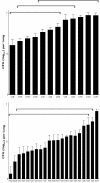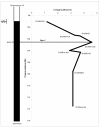Genetic control of Bordetella pertussis infection: identification of susceptibility loci using recombinant congenic strains of mice
- PMID: 15664912
- PMCID: PMC547026
- DOI: 10.1128/IAI.73.2.741-747.2005
Genetic control of Bordetella pertussis infection: identification of susceptibility loci using recombinant congenic strains of mice
Abstract
Susceptibility to and severity of Bordetella pertussis infection in infants and children vary widely. The spectrum of clinical symptoms ranges from subclinical infection to mild disease, severe whooping cough, and death. The aims of this study were to examine genetic susceptibilities of mice to B. pertussis and to identify genetic loci in the mouse genome that are involved in susceptibility to B. pertussis infection. For this purpose we screened two sets of recombinant congenic strains (RCS) of mice, HcB and CcS, for differences in the numbers of bacteria in the lung 7 days after inoculation. For both CcS and in HcB mice, a wide range in numbers of bacteria in the lung was found, suggesting that the course of infection is under multigenic control. From both RCS sets of mice, we selected one strain to identify possible susceptibility loci in F(2) hybrid mice. The degree of lung colonization 7 days postinoculation in these F(2) mice was evaluated in relation to genetic markers by linkage analysis. We found three novel loci that are involved in the control of B. pertussis infection. One locus, designated B. pertussis susceptibility locus 1 (Bps-1), was identified on chromosome 12. The presence of the C57BL/10 genome on this locus instead of the C3H genome significantly decreased the number of B. pertussis bacteria in the lung. Bps-1 has a dominant-positive effect on the clearance of B. pertussis from the lung. The function of most genes in this region is unknown. Two other loci, Bps-2 and Bps-3, showed genetic interaction and are located on chromosomes 5 and 11. We aim to identify the gene(s) in these regions which modify susceptibility to B. pertussis.
Figures





Similar articles
-
Lung response to Bordetella pertussis infection in mice identified by gene-expression profiling.Immunogenetics. 2007 Jul;59(7):555-64. doi: 10.1007/s00251-007-0227-5. Epub 2007 May 9. Immunogenetics. 2007. PMID: 17487483 Free PMC article.
-
Comparative gene expression profiling in two congenic mouse strains following Bordetella pertussis infection.BMC Microbiol. 2007 Oct 12;7:88. doi: 10.1186/1471-2180-7-88. BMC Microbiol. 2007. PMID: 17935610 Free PMC article.
-
Host genetics of Bordetella pertussis infection in mice: significance of Toll-like receptor 4 in genetic susceptibility and pathobiology.Infect Immun. 2006 May;74(5):2596-605. doi: 10.1128/IAI.74.5.2596-2605.2006. Infect Immun. 2006. PMID: 16622195 Free PMC article.
-
Bordetella pertussis and vaccination: the persistence of a genetically monomorphic pathogen.Infect Genet Evol. 2010 Jan;10(1):36-49. doi: 10.1016/j.meegid.2009.10.007. Epub 2009 Oct 30. Infect Genet Evol. 2010. PMID: 19879977 Review.
-
Mouse and pig models for studies of natural and vaccine-induced immunity to Bordetella pertussis.J Infect Dis. 2014 Apr 1;209 Suppl 1:S16-9. doi: 10.1093/infdis/jit488. J Infect Dis. 2014. PMID: 24626866 Review.
Cited by
-
Lung response to Bordetella pertussis infection in mice identified by gene-expression profiling.Immunogenetics. 2007 Jul;59(7):555-64. doi: 10.1007/s00251-007-0227-5. Epub 2007 May 9. Immunogenetics. 2007. PMID: 17487483 Free PMC article.
-
Comparative gene expression profiling in two congenic mouse strains following Bordetella pertussis infection.BMC Microbiol. 2007 Oct 12;7:88. doi: 10.1186/1471-2180-7-88. BMC Microbiol. 2007. PMID: 17935610 Free PMC article.
-
Host genetics of Bordetella pertussis infection in mice: significance of Toll-like receptor 4 in genetic susceptibility and pathobiology.Infect Immun. 2006 May;74(5):2596-605. doi: 10.1128/IAI.74.5.2596-2605.2006. Infect Immun. 2006. PMID: 16622195 Free PMC article.
-
Interspecific recombinant congenic strains between C57BL/6 and mice of the Mus spretus species: a powerful tool to dissect genetic control of complex traits.Genetics. 2007 Dec;177(4):2321-33. doi: 10.1534/genetics.107.078006. Epub 2007 Oct 18. Genetics. 2007. PMID: 17947429 Free PMC article.
-
Mucosal innate response stimulation induced by lipopolysaccharide protects against Bordetella pertussis colonization.Med Microbiol Immunol. 2010 May;199(2):103-8. doi: 10.1007/s00430-010-0142-5. Epub 2010 Feb 9. Med Microbiol Immunol. 2010. PMID: 20143087
References
-
- Badalova, J., M. Svobodova, H. Havelkova, V. Vladimirov, J. Vojtiskova, J. Engova, T. Pilcik, P. Volf, P. Demant, and M. Lipoldova. 2002. Separation and mapping of multiple genes that control IgE level in Leishmania major infected mice. Genes Immun. 3:187-195. - PubMed
-
- Barnard, A., B. P. Mahon, J. Watkins, K. Redhead, and K. H. Mills. 1996. Th1/Th2 cell dichotomy in acquired immunity to Bordetella pertussis: variables in the in vivo priming and in vitro cytokine detection techniques affect the classification of T-cell subsets as Th1, Th2 or Th0. Immunology 87:372-380. - PMC - PubMed
-
- Belcher, C. E., J. Drenkow, B. Kehoe, T. R. Gingeras, N. McNamara, H. Lemjabbar, C. Basbaum, and D. A. Relman. 2000. The transcriptional responses of respiratory epithelial cells to Bordetella pertussis reveal host defensive and pathogen counter-defensive strategies. Proc. Natl. Acad. Sci. USA 97:13847-13852. - PMC - PubMed
-
- Cherry, J. D. 1999. Epidemiological, clinical, and laboratory aspects of pertussis in adults. Clin. Infect. Dis. 28(Suppl.)2:S112—S117. - PubMed
-
- Churchill, G. 2004. QTL mapping overview. [Online.] http://www.jax.org/staff/churchill/labsite/research/qtl/. Accessed 13 April 2004.
MeSH terms
Substances
LinkOut - more resources
Full Text Sources
Medical
Molecular Biology Databases
Miscellaneous

